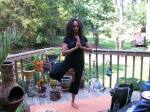
Downward Facing Dog is one of the most popular Yoga inversion poses. An inversion is a reversal of the usual or natural order of things. Total body strength, improved circulation and digestion, and stimulated memory are just a few of the benefits of Yoga inversion poses.
The frequency in which Downward Facing Dog is used in most Yoga classes might annoy you in the beginning, but after you reach your level of comfort, you will love this pose. And it gets easier and more satisfying the more you practice it. This pose stimulates you and warms your body, while simultaneously lengthening and stretching it. Downward Facing Dog requires your total thoughts and concentration as you find a comfortable weight distribution between your legs, arms, and torso. You develop balance and strength as you stretch, lengthen, and align your spine.
When used in Ashtanga Sun Salutations or Yoga Flow classes, Downward Facing Dog is a pose that you continually repeat and return to. It is also a resting pose, rejuvenating, and realigning pose that slows down the asana flow, allowing you to catch your breath.
Getting into the Downward Facing Dog Pose
Be patient with yourself and your body as you practice this pose. Don’t be tense, aggravated, or pushy. Listen to your body and stop when your body tells you to stop. Remember to breath conciously and deeply.
Prevent Injuries
Don’t:
- Round your back
- Hunch your shoulders
- Look up because this can cause neck strain
- Bend your elbows
- Put all of your weight on your wrists
Talk to your doctor before attempting this pose if you have spinal or wrist injuries. If you are on your monthly menstrual cycle, do not remain in this position for more than two breaths.
Getting Down
Distribute most of your weight towards your heels and away from your wrists. Make sure that you lengthen as much as you can. Use all of the mat.
Make sure that you lengthen as much as you can. Use all of the mat.
- Start on your hands and knees. Your arms should be as far apart as your shoulders and your knees should be hip distance apart. Situate your hands slightly above your shoulders and your knees directly below your hips.
- Spread your fingers out wide, pressing firmly into the mat. Your weight should be more towards your palms, thumbs, and your first fingers.
- Inhale, and lift your hips toward the ceiling and push back as you straighten your legs, lengthening and elongating your spine.
- Press your chest towards your thighs, which should make you push back on your heels.
- Push your heels toward the floor, stretching your calf and hamstring muscles.
- Push your tailbone towards the ceiling. Keep your knees straight, but don’t lock them.
- Let your head hang between two straight, strong arms, and gaze between your knees.
 Counter poses
Counter poses
To come out, inhale and return to your hands and knees, and either release into Cow pose or into Child’s pose.
Variations for Beginners
Your hamstrings might be too tight, which will prevent you from fully unfurling. If this is the case, you can bend your knees.
What you will feel
You will feel your hamstrings and calves lengthening, your upper back and shoulders extend, and your arms stretch. Your chest and armpits open. Your lower back arching.
*Disclaimer: As with any exercise regimen, consult your doctor or physician before you start. The Leisure Living Blog, its contributors, or listed resources are not responsible for any injuries.
© 2009 KaTrina Love Abram

 Writing and Yoga
Writing and Yoga
 coaxing confidence. I can focus on one thought at a time, I’m peaceful and calm, and my mind is lucid. I accept where I am at the moment and embrace my limitations. I am patient with myself. This focusing, balance, acceptance, and patience blankets me as I sit at my keyboard and escape into my plot, allowing my characters to live and breath through my fingers.
coaxing confidence. I can focus on one thought at a time, I’m peaceful and calm, and my mind is lucid. I accept where I am at the moment and embrace my limitations. I am patient with myself. This focusing, balance, acceptance, and patience blankets me as I sit at my keyboard and escape into my plot, allowing my characters to live and breath through my fingers. This week, I want to give you a variety of Sun Salutation vinyasas. You can adapt Sun Salutations to suit your mood, energy level, or available time, and let your practice shine. This first series is from Richard Rosen at
This week, I want to give you a variety of Sun Salutation vinyasas. You can adapt Sun Salutations to suit your mood, energy level, or available time, and let your practice shine. This first series is from Richard Rosen at 







